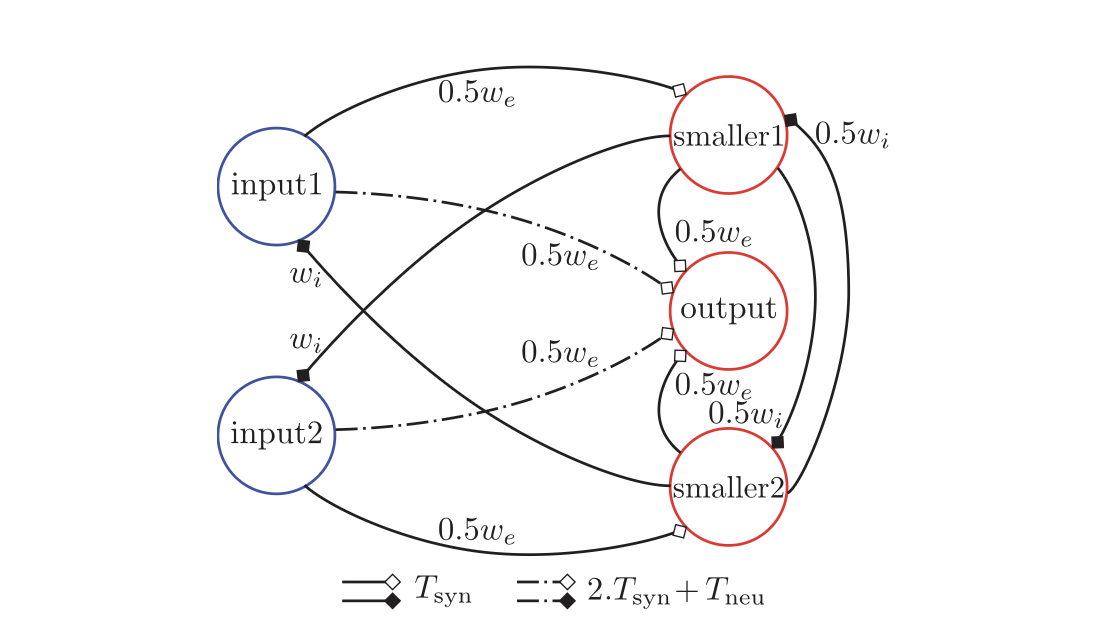Building custom spiking modules
In other tutorials, we have used the spiking modules provided by the Axon SDK library or combined them to define complex computations. However, in certain cases one might need to define modules from scratch. Axon SDK provides an infrastructure to do that.
In this tutorial, we will implement from scratch a module that computes the minimum between two input values. This is, a MinNetwork module, which is not part of the Axon library (yet).
MinNetwork: compute the minimum
Axon is based on the theoretical foundation introduced by the STICK framework, presented in the paper STICK: Spike Time Interval Computational Kernel, A Framework for General Purpose Computation using Neurons, Precise Timing, Delays, and Synchrony. In the paper, there is a design for a spiking network that computes the minimum between two floating point values, which is the one we will implement in this tutorial.
Note: For a deep understanding of the operating principles behind STICK and the workings of the minimum network, the STICK paper contains a great explanation. If you’re interested in learning about it, please, refer to the paper. This tutorial will only address the implementation and simulation of the network in Axon.
This is the spiking network presented in the paper to compute the minimum between two inputs:

Let’s break down the meaning of the graph, step by step.
Each node represents a spiking neuron and each edge, a synaptic connection.
Each synapse has 3 parameters which define it’s properties:
Synapse
| - type
| - weight
| - delay
All synapses are black and therefore V-type synapses (as presented in the paper).
The weight of each synapse is plotted by it. We can see the values we, wi and combinations of them with a preceding factor. The weight we stands for weight excitatory and means that a synapse with weight we will cause the receiving neuron to spike immediately (in the next update cycle). The wi stands for weight inhibitory and has the contrary effect: After receiving a wi synapse, a neuron will need 2x we to spike.
The delays of the synapses, indicated by the line type, have the values Tsyn and Tsyn + Tneu. The first, Tsyn, stands for synapse time and it’s an arbitrary but constant value, usually set to Tsyn=1. The second, Tneu stands for neuron propagation time and is the time a neuron takes to spike after its membrane potential went over the spiking threshold. Since we’re using a sequential simulator, Tneu = dt.
Presenting the SpikingNetworkModule
All spiking modules must be childs of a base class called SpikingNetworkModule. Creating new modules requires subclassing it as well.
from axon_sdk.primitives import SpikingNetworkModule
class MinNetwork(SpikingNetworkModule):
def __init__(self, encoder, module_name=None):
super().__init__(module_name)
...
The SpikingNetworkModule does basic housekeeping: keeps track of child submodules and neurons, makes sure submodules have unique IDs, and provides methods to wire larger modules together. In short, it allows modularity and composability when building complex spiking networks.
Building the Minimum Network
We can follow the graph describin the minimum network from the STICK paper and wire a new spiking module:
class MinNetwork(SpikingNetworkModule):
def __init__(self, encoder, module_name='min_network'):
super().__init__(module_name)
# neuron params
Vt = 10.0 # threshold voltage
tm = 100.0
tf = 20.0
# synapse params
we = Vt
wi = -Vt
Tsyn = 1.0
Tneu = 0.01
self.input1 = self.add_neuron(Vt, tm, tf, neuron_name='input1')
self.input2 = self.add_neuron(Vt, tm, tf, neuron_name='input2')
self.smaller1 = self.add_neuron(Vt, tm, tf, neuron_name='smaller1')
self.smaller2 = self.add_neuron(Vt, tm, tf, neuron_name='smaller2')
self.output = self.add_neuron(Vt, tm, tf, neuron_name='output')
# from input1
self.connect_neurons(self.input1, self.smaller1, "V", 0.5 * we, Tsyn)
self.connect_neurons(self.input1, self.output, "V", 0.5 * we, 2 * Tsyn + Tneu)
# from input2
self.connect_neurons(self.input2, self.smaller2, "V", 0.5 * we, Tsyn)
self.connect_neurons(self.input2, self.output, "V", 0.5 * we, 2 * Tsyn + Tneu)
# from smaller1
self.connect_neurons(self.smaller1, self.input2, "V", wi, Tsyn)
self.connect_neurons(self.smaller1, self.output, "V", 0.5 * we, Tsyn)
self.connect_neurons(self.smaller1, self.smaller2, "V", 0.5 * wi, Tsyn)
# from smaller2
self.connect_neurons(self.smaller2, self.input1, "V", wi, Tsyn)
self.connect_neurons(self.smaller2, self.output, "V", 0.5 * we, Tsyn)
self.connect_neurons(self.smaller2, self.smaller1, "V", 0.5 * wi, Tsyn)
Once built, we can use the simulator to run the dynamics of the network. Refer to the tutorial on Combining computations for a longer explanation about the simulator.
from axon_sdk.simulator import Simulator
from axon_sdk.primitives import DataEncoder
encoder = DataEncoder(Tmin=10.0, Tcod=100.0)
min_net = MinNetwork(encoder, 'min')
sim = Simulator(min_net, encoder)
What’s the smaller value between 0.7 and 0.2? That’s a hard question. Let’s find it out:
val1 = 0.7
val2 = 0.2
sim.apply_input_value(val1, min_net.input1, t0=0)
sim.apply_input_value(val2, min_net.input2, t0=0)
sim.simulate(300)
Now, we can readout the spikes produced by the output neuron and decode the computed result:
spikes = sim.spike_log.get(min_net.output.uid, [])
spikes
>> [2.0100000000000002, 32.01]
encoder.decode_interval(spikes[1] - spikes[0])
>> 0.19999999999999996